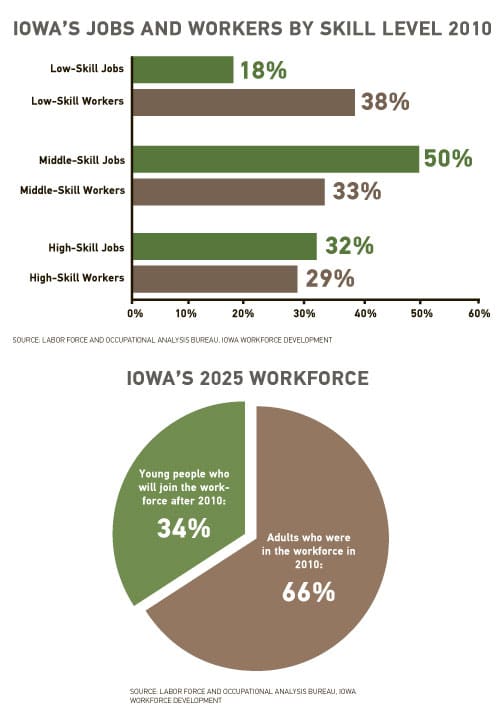Closing the gap
Iowa Workforce Development aims to close skills gap through education, training

A standardized skills test and unpaid training internships for unemployed workers are two tools Iowa’s Workforce Development agency is using to move the bulk of lower skilled Iowans into the jobs that the state needs.
Iowa’s 5 percent unemployment rate isn’t just a matter of too many workers and not enough jobs. Some employers say they are unable to fill open positions because they can’t find qualified workers.
A May Iowa Workforce Development report helped explain part of the problem:
About 50 percent of Iowa job openings are in the middle-skill job range. These jobs can be found across all industries, from manufacturing and construction to finance and business services. They require more than a high school diploma but less than a four-year college degree. But only 33 percent of Iowa’s workers are considered to be middle-skill workers.
At the same time, 38 percent of workers are categorized as low-skill workers. They are vying for low-skill employment, which accounts for only about 18 percent of Iowa jobs.
The problem can’t be solved simply by providing more middle-skills education for young people entering the workforce, said Teresa Wahlert, director of Iowa Workforce Development (IWD). By 2025, two-thirds of the state’s workforce will have been working adults since 2010, according to the report.
Wahlert, said the state hopes to solve the problem in part by elevating the skills of Iowans who’ve been in the workforce for several years. In June of this year, the department launched the Skilled Iowa Initiative, which aims to close the skills gap in two ways. First, with a standardized test that will certify those workers who have the skills for the jobs. And second, by working with employers who are willing to train unemployed workers as part of an unpaid internship. The workers would get the training for free, while collecting unemployment.
“Our job is to be an employment agency. That’s why I’m always livid when someone calls us an unemployment office,” she said. “No one would want to walk into an unemployment office. We pride ourselves in skill development, partnership with business, economic development and education. You have to have a vision that promotes the individual as well as the businesses within the state.”
National Career Readiness Certificate
The test, a product of ACT, Inc., is being used in about 40 states and is the standard for large organizations, including the National Association of Manufacturers.
The state pays for the 90-minute proctored exam, which it believes is a proven, standardized way of assessing skill levels, Wahlert said.
“It’s a commitment to standard education and basic skills,” she said.
IWD aims to have 5 percent of the state’s 1.5 million total workforce be certificate holders, Wahlert said,. That would be 75,000 Iowa workers. She added that between 16,000 and 17,000 Iowa residents already have received a certificate.To promote the certificate, the state is asking businesses to support the program by requiring the certification for at least one job opening.

“We need as many businesses as we can to participate,” Wahlert said. The goal is that 10 percent of Iowa’s 70,000 businesses participate.
Greater Des Moines companies that have signed on include MidAmerican Energy, which has already filled several job openings with job seekers who were certificate-holders, and Principal Financial Group.
“As a company that hires employees with very specific skill sets, we appreciate the state’s support for and promotion of the National Career Readiness Certificate testing,” said Maureen Sammon, MidAmerican’s senior vice president and chief administrative officer. “The program helps employers, like MidAmerican, evaluate a worker’s abilities and place them in a job that suits their skills and the company’s needs.
“The Skilled Iowa Initiative will help Iowa’s economy over the long term by matching employers and employees successfully and keeping industries, jobs and employees in the state,” she said.
Wahlert, who would like students, employed workers and unemployed Iowans alike to receive their certifications, said she required every Workforce Development employee to take the test. “It’s not an easy test,” she said.
The state estimates it will cost between $300,000 and $500,000 to pay for testing. Philanthropist Bill Knapp donated and helped raise more than $300,000 private funding to market the program. Wahlert said her agency has a goal of raising $500,000.
“Bill Knapp has got a passion to help people get a job,” Wahlert said. “What’s difficult for us to do as a state agency is to significantly market a single program. Bill helped us raise private funds to use that money to really promote the plan, promote the initiative, and get people back to work.”
Unemployment internships
A second aspect of the Skilled Iowa Initiative is a training internship program set up through a business or company that will teach an unemployed Iowa resident new skills.
“We are actually training to certain skills,” she said. “We try not to just help someone find employment, but we’re also trying to upskill them and give them something to market about themselves. We don’t just want to give people low-paying jobs.”
The program is modeled after a similar idea in Georgia, Wahlert said. However, Georgia’s program was implemented with one-time money that has run out. The program also ran into labor department issues.
Wahlert said a Waukee-based lumber supply company served as a guinea pig for the idea, adding it chose to hire the unemployed intern after only three weeks.
Companies must provide detailed training plans to be able to participate and must be approved, she said. The state then matches applicants to positions, giving military veterans preference, Wahlert said. The department is working with 23 companies to develop training programs, and recently approved the programs of two companies and is in the process of filling the intern vacancies.
Interns work 24 hours a week for 8 weeks, Wahlert said. They receive no compensation, instead they continue collecting their unemployment benefits. Additionally, businesses are not required to offer interns full-time positions at the end of the program.
“And if it’s not working out at any time, people can walk away or businesses can walk away without any harm or any foul,” she said. “We view this as a win-win for a person to get matched for a job and for businesses who continue to say ‘We can’t find the skilled labor to perform the jobs that we have open.’”
How to get involved:
Businesses interested in taking part in the program must complete a form, located at www.skillediowa.org and allow Iowa Workforce Development use its name in marketing efforts.
What are middle-skill jobs?
Half of Iowa’s jobs are classified as middle-skill level, meaning they generally require more than a high-school diploma, but less than a four-year degree. People who fill these jobs generally have gained an associate’s degree or a certification or apprenticeship.











